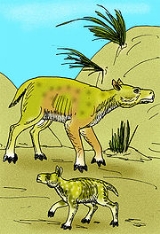
Sespia
Encyclopedia
Sespia is an extinct genus
of terrestrial
herbivore
of the family
Merycoidodontidae, subfamily Merycoidodontinae (an oreodont
), endemic to North America
during the Whitneyan
stage of the Oligocene
-Late Oligocene epochs (30.8—24.8 mya) existing for approximately .
-sized and desert
-dwelling. The genus was closely related to the larger Leptauchenia
.
A single specimen was examined by M. Mendoza for body mass and estimated to have a weight of 4.65 kg (10.2 lbs).
, namely, in Chula Vista, and Carlsbad, and is known from literally thousands of specimens. The largest species, the goat-sized S. ultima, is known from late Oligocene deposits in Nebraska
. S. ultima was once placed in a separate, monotypic genus, as Megasespia middleswarti. Other species were once placed within Leptauchenia.
(ancestral) , Leptauchenia
(syn. Brachymeryx, Cyclopidius, Hadroleptauchenia, Pithecistes, Pseudocyclopidius)
Genus
In biology, a genus is a low-level taxonomic rank used in the biological classification of living and fossil organisms, which is an example of definition by genus and differentia...
of terrestrial
Terrestrial animal
Terrestrial animals are animals that live predominantly or entirely on land , as compared with aquatic animals, which live predominantly or entirely in the water , or amphibians, which rely on a combination of aquatic and terrestrial habitats...
herbivore
Herbivore
Herbivores are organisms that are anatomically and physiologically adapted to eat plant-based foods. Herbivory is a form of consumption in which an organism principally eats autotrophs such as plants, algae and photosynthesizing bacteria. More generally, organisms that feed on autotrophs in...
of the family
Family (biology)
In biological classification, family is* a taxonomic rank. Other well-known ranks are life, domain, kingdom, phylum, class, order, genus, and species, with family fitting between order and genus. As for the other well-known ranks, there is the option of an immediately lower rank, indicated by the...
Merycoidodontidae, subfamily Merycoidodontinae (an oreodont
Oreodont
Oreodons, sometimes called prehistoric "ruminating hogs," were a family of cud-chewing plant-eater with a short face and tusk-like canine teeth...
), endemic to North America
North America
North America is a continent wholly within the Northern Hemisphere and almost wholly within the Western Hemisphere. It is also considered a northern subcontinent of the Americas...
during the Whitneyan
Whitneyan
The Whitneyan North American Stage on the geologic timescale is the North American faunal stage according to the North American Land Mammal Ages chronology , typically set from 33,300,000 to 30,800,000 years BP, a period of . It is usually considered to fall within the Early Oligocene...
stage of the Oligocene
Oligocene
The Oligocene is a geologic epoch of the Paleogene Period and extends from about 34 million to 23 million years before the present . As with other older geologic periods, the rock beds that define the period are well identified but the exact dates of the start and end of the period are slightly...
-Late Oligocene epochs (30.8—24.8 mya) existing for approximately .
Taxonomy
Sespia was named by Schultz and Falkenbach (1968) as a subgenus of Leptauchenia by Stock in 1930; transferred to Cyclopidius by Schlaikjer 1935, Thorpe 1937. Its type is Leptauchenia nitida. It was assigned to Merycoidodontidae by Schultz and Falkenbach (1968) and Lander (1998).Morphology
Sespia was house cat-sized to goatGoat
The domestic goat is a subspecies of goat domesticated from the wild goat of southwest Asia and Eastern Europe. The goat is a member of the Bovidae family and is closely related to the sheep as both are in the goat-antelope subfamily Caprinae. There are over three hundred distinct breeds of...
-sized and desert
Desert
A desert is a landscape or region that receives an extremely low amount of precipitation, less than enough to support growth of most plants. Most deserts have an average annual precipitation of less than...
-dwelling. The genus was closely related to the larger Leptauchenia
Leptauchenia
Leptauchenia is an extinct goat-like genus of terrestrial herbivore belonging to the oreodont family Merycoidodontidae, and the type genus of the tribe Leptaucheniini...
.
A single specimen was examined by M. Mendoza for body mass and estimated to have a weight of 4.65 kg (10.2 lbs).
Fossil distribution
Fossils of the best known species, the cat-sized S. californica, have been found CaliforniaCalifornia
California is a state located on the West Coast of the United States. It is by far the most populous U.S. state, and the third-largest by land area...
, namely, in Chula Vista, and Carlsbad, and is known from literally thousands of specimens. The largest species, the goat-sized S. ultima, is known from late Oligocene deposits in Nebraska
Nebraska
Nebraska is a state on the Great Plains of the Midwestern United States. The state's capital is Lincoln and its largest city is Omaha, on the Missouri River....
. S. ultima was once placed in a separate, monotypic genus, as Megasespia middleswarti. Other species were once placed within Leptauchenia.
Species
S. californica, S. heterodon, S. nitida (syn. Leptauchenia minora, S. marianae), S. ultima (syn. Megasespia middleswarti).Sister genera
LimnenetesLimnenetes
Limnenetes is an extinct genus of oreodont, endemic to North America during the Late Eocene-Early Oligocene subepochs existing for approximately .Limnenetes was a herbivore with a heavy body, long tail, short feet, and four-toed hooves....
(ancestral) , Leptauchenia
Leptauchenia
Leptauchenia is an extinct goat-like genus of terrestrial herbivore belonging to the oreodont family Merycoidodontidae, and the type genus of the tribe Leptaucheniini...
(syn. Brachymeryx, Cyclopidius, Hadroleptauchenia, Pithecistes, Pseudocyclopidius)
External links
- http://www.sdnhm.org/exhibits/mystery/fg_sespia.html San Diego Natural History MuseumSan Diego Natural History MuseumThe San Diego Natural History Museum was founded in 1874 as the San Diego Society of Natural History. The present location of the museum in San Diego's Balboa Park was dedicated on January 14, 1933....
"Fossil Mysteries Field Guide: Sespia californica

